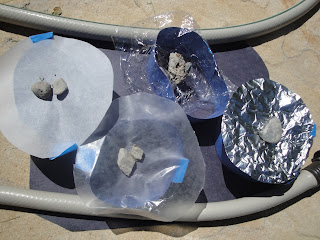SMMART SCIENCE: Atmosphere
Even WITH the strata of our earth's atmosphere, the sun's penetrating heat is so powerful, that it warms the earth, and can burn our unprotected skin after a few hours
"We are enveloped by an atmosphere that consists of 78 percent nitrogen, 21 percent oxygen and 1 percent other ingredients. The atmosphere affects Earth's long-term climate and short-term local weather, shields us from much of the harmful radiation coming from the sun and protects us from meteors as well: most of which burn up before they can strike the surface as meteorites. Earth-orbiting satellites have revealed that the upper atmosphere actually swells by day and contracts by night due to solar heating during the day and cooling at night."(http://solarsystem.nasa.gov/planets/profile.cfm?Object=Earth&Display=OverviewLong)
These activities will help your child recognize two purposes of our atmosphere-to insulate, and to protect.
Gather five mason jars or mugs and fill them each with a cup of water. Place various covers on each mason jar lip and secure with a rubber band. You could use wax paper, a wash cloth, celophane wrap, and a brown paper bag piece. Leave one jar uncovered. Place the jars in the sun for a few hours. Have your child use a thermometer, or just use their finger, to determine which jar holds the hottest water. Which cover allowed the most sunlight through and which jar cover allowed the least sunlight through? All of the covers insulated the area inside of the jar. By definition, Insulation prevents or reduces the passage of heat, electricity or sound. Did any of the jar covers reduce the passage of the sun's heat the best?
This activity shows a visual effect of the sun's power:
-Cut the top and bottoms from 5 rinsed tuna cans. (You could also cut 5 strips of construction paper and tape into a circle to use as your base.)
-Place covers on four of the cans and secure with a rubber band. You could use wax paper, a wash cloth, celophane wrap, tin foil, or the bottom of a balloon stretched over the rim. Lay the cans on top of a piece of construction paper in a sunny area for the day.
-Label the paper beside each can naming the type of cover on the can. After a day, have your child remove the cans from the construction paper. Notice the faded circles on the construction paper. Observe which cover allowed more of the sun's rays through and which covers allowed the fewest rays through. Explain that our atmosphere protects the earth, the plants and our bodies from too strong of sunrays. The more faded circles had an "atmosphere layer" that allowed more penetration than the less faded circles.(http://www.kids-science-experiments.com/)




